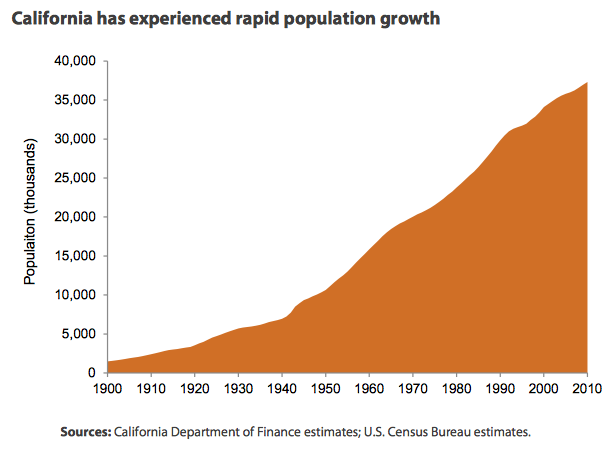 On the last day of 2013, one bad statistic is the amount of rainfall for California; this year has been among the driest around the state, and the driest ever on record in San Francisco.
On the last day of 2013, one bad statistic is the amount of rainfall for California; this year has been among the driest around the state, and the driest ever on record in San Francisco.
The average precipitation for the city, as recorded from 1849, is around 21 inches; this year saw only 5.59 inches.
Elsewhere, Yosemite Valley got only 11.24 inches of rain, not even a third of its average 35.95 inches. Coastal Santa Cruz normally sees over 30 inches of precipitation in a year, but received just 4.78 inches in 2013.
The state has begun to increase in population growth once again as jobs pick up somewhat, after being hard hit with double-digit unemployment lasting four years during the recession. Around 300,000 new residents now arrive annually, and the total population is around 38 million resource users.
That’s a lot of persons requiring water, particularly for a region that has suffered two century-plus droughts in recent history, starting only 1100 years ago.
Why are the limits to growth as related to water supply never discussed by elected officials? Must Californians suffer increasing water restrictions and rock gardens instead of grass so that another 10 million Mexicans can be crammed in?
Washington plans on importing tens of millions of immigrants in the next decades, with no thought at all about whether the natural resources can support them.

Driest year ever in Calif. sparks fire, water fears, USA Today, December 26, 2013
California is enduring its driest calendar year on record, with no signs of relief coming anytime soon. In San Francisco, the city is seeing its driest year since records began during the Gold Rush year of 1849.
Although a drought emergency has not yet been officially declared, a lack of rain and snow this winter could bring catastrophic losses to California agriculture, as water allotments are slashed by state agencies.
“Soil moisture is depleted, reservoir storage is down and even if we had average rainfall statewide, we probably wouldn’t see average runoff just because soil moisture is so depleted,” California Department of Water Resources deputy drought manager Jeanine Jones said last week.
In Southern California, through Tuesday, the weather station in downtown Los Angeles had received only 3.6 inches of rain so far in 2013, according to the National Weather Service. If no more rain falls, this would make 2013 the city’s driest calendar year on record, breaking the record of the previous driest years, 1947 and 1953, when 4.08 inches fell each year.
In a typical year, Los Angeles receives 14.91 inches of rain; records in the city go back to 1877. “Many other locations around the region are approaching similar dubious record or near-record dry calendar years,” climatologist Mark Svoboda noted in the most recent U.S. Drought Monitor, a federal website that tracks drought across the country.
The U.S. Drought Monitor reported that 94.25% of the state is enduring some level of drought conditions and that most of the prime agriculture area of the Central Valley is in extreme drought, the second-worst category.
At least 90% of the state has been in a drought since early May.
Other Western states, such as Oregon, Idaho and Nevada, are also seeing drought conditions, according to the Drought Monitor. Some spots in southern Oregon are also on the brink of record dry years.
Earlier this month, several federal and California lawmakers called on Calif. Gov. Jerry Brown and President Obama to declare a drought emergency and a federal disaster in the state.
“We have had two years of dry conditions that have depleted our reservoirs and reduced carry-over storage to historically low levels not seen since 1977,” Sen. Dianne Feinstein (D-Calif.) and Rep. Jim Costa (D-Calif.) wrote in the letter to Brown and Obama.
Brown has formed an interagency task force to monitor the potential for a statewide formal drought declaration.
The drought helped fuel an unusual December wildfire from Dec. 15-22 near Big Sur in Northern California. Though the fire is now contained, it destroyed dozens of homes and forced about 100 evacuations, AccuWeather reported. The blaze burned more than 900 acres.
Catastrophic wildfires remain the greatest risk the state would likely face next year after a third-straight dry winter: “A couple of the state’s most disastrous wildfire events occurred in Southern California in 2003 and 2007, following drought conditions,” Jones said.
A large blocking ridge of high pressure in the eastern Pacific and Gulf of Alaska has caused the lack of rain and snow this year, said meteorologist Jan Null of Golden Gate Weather Services, a private firm. He said the ridge diverts the storms over it and forces them instead into the middle of the country and across into the East.
The dryness should continue: No rain or snow is in the forecast for at least the next seven days anywhere in the state of California, according to the Weather Prediction Center. And the long-range forecast from the Climate Prediction Center is also not promising: below-average rain and snow for all of central and Southern California through March.